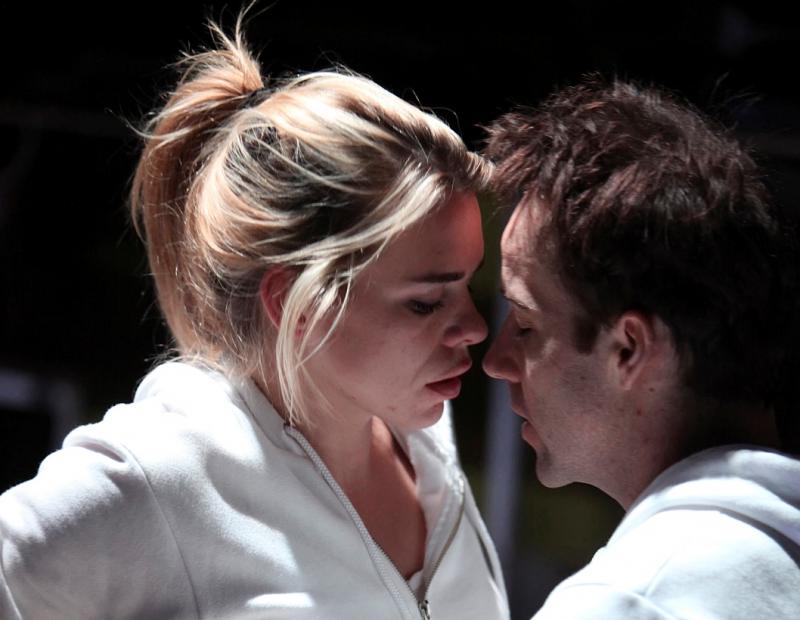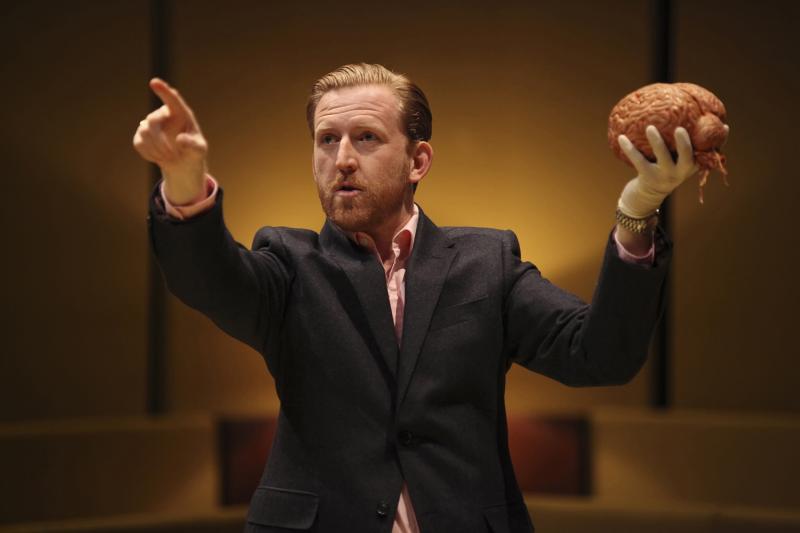The Effect, National Theatre | reviews, news & interviews
The Effect, National Theatre
The Effect, National Theatre
Billie Piper stars in Enron playwright Lucy Prebble’s stimulating, compelling and moving new play

Science thrives on stage. In play after play, various scientific ideas seem to flourish in the warm, well-lit environment of the theatre, fed by a crew of artists and despite the threats of critics or other predators. Now, Lucy Prebble — fresh from her outstanding success with Enron — turns her attention to the subject of love and neurology in her latest play, which opened last night.
The short answer is yes. For a longer answer, read on. The Effect is set in a facility managed by Raushen, a pharmaceutical company which is running clinical trials of a new dopamine-heavy drug that could cure depression. The experiment is a four-week residential test with strict rules. Prebble focuses on two young volunteers: Connie (Piper) and Tristan. They are from different backgrounds: she is a psychology student from Basingstoke while he is a drifter from Coleraine.
A super-Prozac pill is the holy grail of neuroscience
As the intensive experiment progresses, Connie and Tristan are attracted to each other. But is this the result of the happy pills they have been popping, or is it a natural attraction? And how could you tell the difference? Can an experience as life-changing as falling in love be just a side effect? To complicate matters, Prebble throws in that essential element in any blind scientific test, the placebo. Now, which of the two volunteers is taking the placebo, and how does that alter what they think they are feeling?
It has to be said that the premise of the play is fascinating, immediately engrossing. In the past, people thought that the soul dwelt in the spleen, but today we are more likely to believe that the mind resides in the brain. And that all neurological problems, including the devastating disability of depression, are caused by chemical imbalances. In two matching mini-lectures by the two doctors in the story — Dr Lorna James and Dr Toby Sealey — the brain, perhaps the most complex object in the known world, is intellectually dissected.
 Of course, the human element is stressed. By giving in to their mutual attraction, Connie and Tristan are breaking the rules of the experiment, much to the dismay of Dr James. She not only tries to control their natural, or drug-induced, urges but she also comes into conflict with Dr Sealey, who believes that a super-Prozac pill is the holy grail of neuroscience. Her attitude is more nuanced, and influenced by her own experience of depression. If love is a drug, sadness is a human curse.
Of course, the human element is stressed. By giving in to their mutual attraction, Connie and Tristan are breaking the rules of the experiment, much to the dismay of Dr James. She not only tries to control their natural, or drug-induced, urges but she also comes into conflict with Dr Sealey, who believes that a super-Prozac pill is the holy grail of neuroscience. Her attitude is more nuanced, and influenced by her own experience of depression. If love is a drug, sadness is a human curse.
As in Enron, Prebble writes with a really impressive command of complex ideas, and her mix of the personal and the political is here nearly perfect. Okay, you could object that they situation is too simplistic, too much like Peter Shaffer’s Equus, but it never feels unsophisticated or jejune. Prebble also chucks in plenty of satirical asides, and there are many fascinating nuggets of information and good jokes. There are oblique references to the Renaissance idea of love as madness and perceptive one liners such as “The history of medicine is the history of placebo”.
 The debate between the two doctors is well balanced and Prebble gives both sides equal weight. The result is humane and compelling. At first I thought that the final 20 minutes of a long evening was a plot twist too far, but actually they turn into a very moving note of healing, of quiet and touching human connection. This is all greatly enhanced by Rupert Goold who — with designer Miriam Buether — has created a chic clinical environment, bland yellow and passionate red, and often covered in projections that convey the abstractions of modern medicine.
The debate between the two doctors is well balanced and Prebble gives both sides equal weight. The result is humane and compelling. At first I thought that the final 20 minutes of a long evening was a plot twist too far, but actually they turn into a very moving note of healing, of quiet and touching human connection. This is all greatly enhanced by Rupert Goold who — with designer Miriam Buether — has created a chic clinical environment, bland yellow and passionate red, and often covered in projections that convey the abstractions of modern medicine.
But the best aspect of the production is the acting. Billie Piper and Jonjo O’Neill deliver beautifully contrasting performances as Connie and Tristan (pictured above right with Anastasia Hille). Piper makes a convincing journey from light-hearted frivolity to emotionally devastated understanding, while he changes from a mouthy and charming youth to a prematurely aged victim. Likewise, Anastasia Hille is brilliant as Dr James, strict, arid but finally deeply human. And as Dr Sealey, Tom Goodman-Hill (pictured above left) is all efficiency, before the doubts overwhelm him. Together, they create an intensive, stimulating and moving evening in what might well be the best new play of the year. That’s what I felt when I left the theatre — surely it couldn’t have just been a temporary chemical imbalance, could it?
Add comment
The future of Arts Journalism
You can stop theartsdesk.com closing!
We urgently need financing to survive. Our fundraising drive has thus far raised £49,000 but we need to reach £100,000 or we will be forced to close. Please contribute here: https://gofund.me/c3f6033d
And if you can forward this information to anyone who might assist, we’d be grateful.

Subscribe to theartsdesk.com
Thank you for continuing to read our work on theartsdesk.com. For unlimited access to every article in its entirety, including our archive of more than 15,000 pieces, we're asking for £5 per month or £40 per year. We feel it's a very good deal, and hope you do too.
To take a subscription now simply click here.
And if you're looking for that extra gift for a friend or family member, why not treat them to a theartsdesk.com gift subscription?
more Theatre
 Cow | Deer, Royal Court review – paradox-rich account of non-human life
Experimental work about nature led by Katie Mitchell is both extraordinary and banal
Cow | Deer, Royal Court review – paradox-rich account of non-human life
Experimental work about nature led by Katie Mitchell is both extraordinary and banal
 Deaf Republic, Royal Court review - beautiful images, shame about the words
Staging of Ukrainian-American Ilya Kaminsky’s anti-war poems is too meta-theatrical
Deaf Republic, Royal Court review - beautiful images, shame about the words
Staging of Ukrainian-American Ilya Kaminsky’s anti-war poems is too meta-theatrical
 Laura Benanti: Nobody Cares, Underbelly Boulevard Soho review - Tony winner makes charming, cheeky London debut
Broadway's acclaimed Cinderella, Louise, and Amalia reaches Soho for a welcome one-night stand
Laura Benanti: Nobody Cares, Underbelly Boulevard Soho review - Tony winner makes charming, cheeky London debut
Broadway's acclaimed Cinderella, Louise, and Amalia reaches Soho for a welcome one-night stand
 The Pitchfork Disney, King's Head Theatre review - blazing with dark energy
Thrilling revival of Philip Ridley’s cult classic confirms its legendary status
The Pitchfork Disney, King's Head Theatre review - blazing with dark energy
Thrilling revival of Philip Ridley’s cult classic confirms its legendary status
 Born with Teeth, Wyndham's Theatre review - electric sparring match between Shakespeare and Marlowe
Rival Elizabethan playwrights in an up-to-the-minute encounter
Born with Teeth, Wyndham's Theatre review - electric sparring match between Shakespeare and Marlowe
Rival Elizabethan playwrights in an up-to-the-minute encounter
 Interview, Riverside Studios review - old media vs new in sparky scrap between generations
Robert Sean Leonard and Paten Hughes make worthy sparring partners
Interview, Riverside Studios review - old media vs new in sparky scrap between generations
Robert Sean Leonard and Paten Hughes make worthy sparring partners
 Fat Ham, RSC, Stratford review - it's Hamlet Jim, but not as we know it
An entertaining, positive and contemporary blast!
Fat Ham, RSC, Stratford review - it's Hamlet Jim, but not as we know it
An entertaining, positive and contemporary blast!
 Juniper Blood, Donmar Warehouse review - where ideas and ideals rule the roost
Mike Bartlett’s new state-of-the-agricultural-nation play is beautifully performed
Juniper Blood, Donmar Warehouse review - where ideas and ideals rule the roost
Mike Bartlett’s new state-of-the-agricultural-nation play is beautifully performed
 The Gathered Leaves, Park Theatre review - dated script lifted by nuanced characterisation
The actors skilfully evoke the claustrophobia of family members trying to fake togetherness
The Gathered Leaves, Park Theatre review - dated script lifted by nuanced characterisation
The actors skilfully evoke the claustrophobia of family members trying to fake togetherness
 As You Like It: A Radical Retelling, Edinburgh International Festival 2025 review - breathtakingly audacious, deeply shocking
A cunning ruse leaves audiences facing their own privilege and complicity in Cliff Cardinal's bold theatrical creation
As You Like It: A Radical Retelling, Edinburgh International Festival 2025 review - breathtakingly audacious, deeply shocking
A cunning ruse leaves audiences facing their own privilege and complicity in Cliff Cardinal's bold theatrical creation
 Edinburgh Fringe 2025 reviews: Refuse / Terry's / Sugar
A Ukrainian bin man, an unseen used car dealer and every daddy's dream twink in three contrasting Fringe shows
Edinburgh Fringe 2025 reviews: Refuse / Terry's / Sugar
A Ukrainian bin man, an unseen used car dealer and every daddy's dream twink in three contrasting Fringe shows
 Faustus in Africa!, Edinburgh International Festival 2025 review - deeply flawed
Bringing the Faust legend to comment on colonialism produces bewildering results
Faustus in Africa!, Edinburgh International Festival 2025 review - deeply flawed
Bringing the Faust legend to comment on colonialism produces bewildering results

Comments
There is no such place as
Thanks for the correction
Though I enjoyed the play, I
Though I enjoyed the play, I